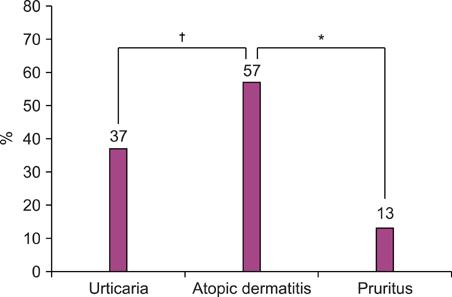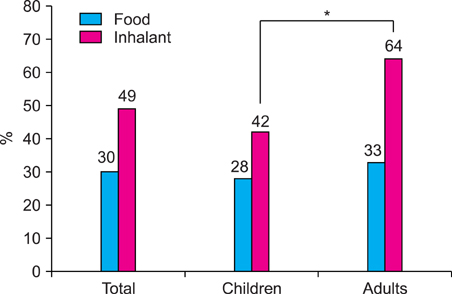Analysis of MAST-CLA Results as a Diagnostic Tool in Allergic Skin Diseases
- Affiliations
-
- 1Department of Dermatology, Seoul National University College of Medicine, Boramae Hospital, Seoul, Korea. sycho@snu.ac.kr
- KMID: 2172034
- DOI: http://doi.org/10.5021/ad.2010.22.1.35
Abstract
- BACKGROUND
Urticaria and atopic dermatitis are representative allergic skin diseases that can be mediated by IgE. Measuring levels of specific IgE can be used to confirm causative agents of these skin diseases.
OBJECTIVE
To analyze results from the multiple allergosorbent test chemiluminescent assay (MAST-CLA), which measures specific IgE in the presence of a causative agent/allergen, in IgE-mediated skin diseases.
METHODS
A total of 404 patients with urticaria, atopic dermatitis or pruritus were enrolled in the present study. Positive rates of specific IgE as well as total serum IgE from the MAST-CLA were compared. RESULTS: Positive rates of specific IgE were highest in atopic dermatitis patients, followed by urticaria, and then pruritus, with 57.0%, 37.1%, and 20.8%, respectively (p<0.05). House dust mite species were the most common allergens in both atopic dermatitis and urticaria skin diseases. There were no differences in the overall MAST-CLA results between acute and chronic urticaria. The relative positive rate of inhalant allergen was significantly higher in adult than in child atopic dermatitis patients.
CONCLUSION
Results from the MAST-CLA showed diversity among the three disease groups, and within each disease group, with different positive rates of specific IgE, a different mean allergen number per patient, and so on. Therefore, we concluded that MAST-CLA could be a useful diagnostic tool for various allergic skin diseases.
Keyword
MeSH Terms
Figure
Cited by 4 articles
-
Filaggrin Mutation in Korean Patients with Atopic Dermatitis
Hye Rang On, Sang Eun Lee, Song-Ee Kim, Won Jin Hong, Hyun Jung Kim, Toshifumi Nomura, Shotaro Suzuki, Hiroshi Shimizu, Soo-Chan Kim
Yonsei Med J. 2017;58(2):395-400. doi: 10.3349/ymj.2017.58.2.395.Clinical Availability of Component-Resolved Diagnosis Using Microarray Technology in Atopic Dermatitis
Joon-Seok Choi, Joo-Young Roh, Jong-Rok Lee
Ann Dermatol. 2014;26(4):437-446. doi: 10.5021/ad.2014.26.4.437.Food Allergy in Korean Patients with Chronic Urticaria
Bo Young Chung, Yong Se Cho, Hye One Kim, Chun Wook Park
Ann Dermatol. 2016;28(5):562-568. doi: 10.5021/ad.2016.28.5.562.Avoidance Behavior against Positive Allergens Detected with a Multiple Allergen Simultaneous Test Immunoblot Assay in Patients with Urticaria: Factors Associated with Avoidance Success/Failure
Min Kyung Lee, In Ho Kwon, Han Su Kim, Heung Yeol Kim, Eun Byul Cho, Youin Bae, Gyeong Hun Park, Eun Joo Park, Kwang Ho Kim, Kwang Joong Kim
Ann Dermatol. 2016;28(1):80-85. doi: 10.5021/ad.2016.28.1.80.
Reference
-
1. Lee IW, Kim TH, Ahn SK, Choi EH. Comparison of MAST chemiluminescent assay(MAST-CLA) with skin prick, test in patients with atopic dermatitis. Korean J Dermatol. 1999. 37:297–304.2. Scolozzi R, Boccafogli A, Vicentini L, Baraldi A, Bagni B. Correlation of MAST chemiluminescent assay (CLA) with RAST and skin prick tests for diagnosis of inhalant allergic disease. Ann Allergy. 1989. 62:193a–193b.3. Lee YJ, Park CW, Lee CH. A study of patients with chronic urticaria using the chemiluminescent assay and prick test. Korean J Dermatol. 1995. 33:260–267.4. Finnerty JP, Summerell S, Holgate ST. Relationship between skin-prick tests, the multiple allergosorbent test and symptoms of allergic disease. Clin Exp Allergy. 1989. 19:51–56.
Article5. Kim HD, Cho MK, Lee SY, Lee JS, Park YL, Whang KU, et al. Evaluation of the MAST CLA allergy system for measuring total and allergen specific IgE in child and adult atopic dermatitis. Korean J Dermatol. 2007. 45:413–421.6. Lee EJ, Piao YJ, Kim KH, Suhr KB, Lee JH, Park JK. The relationship among the clinical evaluation, total IgE, and allergen-specific IgE of MAST-CLA in atopic dermatitis. Korean J Dermatol. 2003. 41:197–206.7. Lee CS, Tang RB, Chung RL. The evaluation of allergens and allergic diseases in children. J Microbiol Immunol Infect. 2000. 33:227–232.8. Park KI, Chun HS, Shin JW, Kim HS, Song KS. Allergen frequencies on MAST CLA by age groups using new Korean panel. J Clin Pathol Qual Control. 1999. 21:243–249.9. Cho YW, Park HS, Oh SH, Hong CS. Immediate skin reactivity to 12 inhalant allergens in a general population of Korea. J Korean Med Assoc. 1987. 30:647–656.10. Tanei R, Katsuoka K. Clinical analyses of atopic dermatitis in the aged. J Dermatol. 2008. 35:562–569.
Article11. Miyamoto T, Oshima S, Ishizaki T, Sato SH. Allergenic identity between the common floor mite (Dermatophagoides farinae Hughes, 1961) and house dust as a causative antigen in bronchial asthma. J Allergy. 1968. 42:14–28.
Article12. Voorhorst R, Spieksma FTM, Varekamp H, Leupen MJ, Lyklema AW. The house-dust mite (Dermatophagoides pteronyssinus) and the allergens it produces. Identity with the house-dust allergen. J Allergy. 1967. 39:325–339.
Article13. Tang RB, Tsai LC, Hung MW, Hwang B, Wu KG. Detection of house dust mite allergens and immunoblot analysis in asthmatic children. J Asthma. 1988. 25:83–88.
Article14. Tang RB, Chang HN, Lin FM, Chang YF, Chou NS, Lin CY. Serum IgE, skin and radioallergosorbent tests for house dust and mites in asthmatic children. J Asthma. 1986. 23:245–249.
Article15. Teplitsky V, Mumcuoglu KY, Babai I, Dalal I, Cohen R, Tanay A. House dust mites on skin, clothes, and bedding of atopic dermatitis patients. Int J Dermatol. 2008. 47:790–795.
Article16. Kang JS, Lee K, Han SB, Ahn JM, Lee H, Han MH, et al. Induction of atopic eczema/dermatitis syndrome-like skin lesions by repeated topical application of a crude extract of Dermatophagoides pteronyssinus in NC/Nga mice. Int Immunopharmacol. 2006. 6:1616–1622.
Article17. Oshio T, Sasaki Y, Funakoshi-Tago M, Aizu-Yokota E, Sonoda Y, Matsuoka H, et al. Dermatophagoides farinae extract induces severe atopic dermatitis in NC/Nga mice, which is effectively suppressed by the administration of tacrolimus ointment. Int Immunopharmacol. 2009. 9:403–411.
Article18. Kato T, Takai T, Fujimura T, Matsuoka H, Ogawa T, Murayama K, et al. Mite serine protease activates protease-activated receptor-2 and induces cytokine release in human keratinocytes. Allergy. 2009. 64:1366–1374.
Article19. Maeda S, Shibata S, Chimura N, Fukata T. House dust mite major allergen Der f 1 enhances proinflammatory cytokine and chemokine gene expression in a cell line of canine epidermal keratinocytes. Vet Immunol Immunopathol. 2009. 131:298–302.
Article20. Host A. Cow's milk protein allergy and intolerance in infancy. Some clinical, epidemiological and immunological aspects. Pediatr Allergy Immunol. 1994. 5:5 Suppl. 1–36.
Article21. Chang DS, Seo SJ, Hong CK. Patch test and specific IgE level with food antigens in atopic dermatitis patients. Korean J Dermatol. 2002. 40:1028–1034.22. Purohit A, Shao J, Degreef JM, van Leeuwen A, van Ree R, Pauli G, et al. Role of tropomyosin as a cross-reacting allergen in sensitization to cockroach in patients from Martinique (French Caribbean island) with a respiratory allergy to mite and a food allergy to crab and shrimp. Eur Ann Allergy Clin Immunol. 2007. 39:85–88.23. Caliskaner Z, Ozturk S, Turan M, Karaayvaz M. Skin test positivity to aeroallergens in the patients with chronic urticaria without allergic respiratory disease. J Investig Allergol Clin Immunol. 2004. 14:50–54.
- Full Text Links
- Actions
-
Cited
- CITED
-
- Close
- Share
- Similar articles
-
- Comparison of MAST Chemiluminescent Assay(MAST-CLA) with Skin Prick, Test in Patients with Atopic Dermatitis
- Cockroach Allergic Rhinitis in the Urban Area in Korea: Sensitivity and Diagnosis
- Evaluation of Chemiluminescent Allergy Assay System
- Correlation between MAST, the skin prick test, and the nasal provocation test in patients with allergic rhinitis
- The Usefulness of Serum Total IgE Test by Multiple Allergosorbent Test-Chemiluminescent Assay(MAST-CLA): Comparison with Paper Radioimmunosorbent Test(PRIST)



